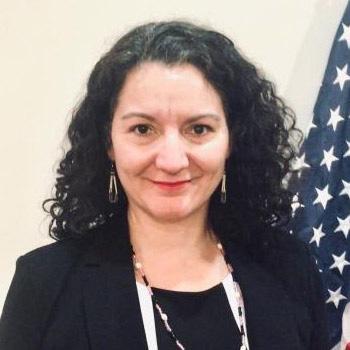SHA RI N G BE S T P R AC T I C E S T O E R ADI C AT E V I O L E NC E , KEEP WOMEN SAFE AND BUILD THEIR RESILIENCE DET. SGT.
ALANA MORRISON
S U R V I VO R A S S I S TA N C E SUPPORT PROGRAM, NISHNAWBE ASKI POLICE SERVICE
When a romantic partner is threatening physical harm, and the remote community outside the door is populated by his friends and family members, Indigenous women can find themselves with nowhere to turn for help. The male officers at the small, local policing stations on reserves can sometimes seem more foreign and frightening than the abusers themselves. But in First Nations communities in northwestern Ontario, a program recently introduced by the Nishnawbe Aski Police Service (NAPS), is connecting women who are victims of violence with caring, female, Indigenous members of the force who provide a shoulder to cry on and a guiding hand out of harm’s way.
NELSY KU CHAY C O O R D I N ATO R , H O U S E S OF INDIGENOUS AND AFRO-MEXICAN WOMEN
AMANDA TASCÓN PANCHI T E C H N I C A L C O O R D I N ATO R O F T H E D E PA R T M E N T O F WOMEN AND GENDER, I N D I G E N O U S O RG A N I Z AT I O N OF ANTIOQUIA
“We find that the calls we receive are basically a woman just wanting to hear that voice on the other end of the line that's comforting, that's supportive, that says, it's going to be okay,” Alana Morrison, the Detective Sergeant of the NAPS Survivor Assistance Support Program who is a survivor of abuse herself, told the International Summit of the Americas on Violence Against Indigenous Women. The women who have been hired to help abuse survivors all have backgrounds in social service work and are educated on intricacies of the judicial system, Det. Morrison said on the second day of the two-day online summit. “We decided that [the regular] officers can be better to focus on the investigation,” she said, “and then our workers can deal with the issues at hand [for the abuse victim] and whatever is going to help her feel safe.” Innovative programs, like this one developed by an Indigenous police service in a remote part of Canada, are being created all across the Americas to reduce the extraordinary number of deaths and disappearances among Indigenous women. But, too often, they operate in silos.
JACQUELINE O’NEILL AMBASSADOR FOR WOMEN, PEACE AND SECURITY, GOVERNMENT OF CANADA
The primary goal of the Native Women’s Association of Canada (NWAC) in hosting the Summit is to break down knowledge barriers and to share best practices that can be deployed in other jurisdictions to keep more Indigenous women safe. “It is so very important to share best practices across the Americas because of what we all have been through for so many generations,” said Alma Brooks, a Maliseet grandmother from St. Mary’s First Nation in New Brunswick who is NWAC’s East Elder. “When we share with one another what has happened to us, we find that the experiences have been similar, which points to the fact that colonization is a well-crafted plan that was implemented across the board on Indigenous Peoples everywhere.”
BRENDA HILL D I R E C TO R O F T E C H N I C A L A S S I S TA N C E & T R A I N I N G , N AT I O N A L I N D I G E N O U S WOMEN’S RESOURCE CENTER
In Mexico, safe houses are being created by Indigenous women for Indigenous women. They are places where women can regain health and where they can share culture, customs, and life experiences, and build trust and raise awareness. (Continued on page 15)
KCI-NIWESQ • NWAC
14








